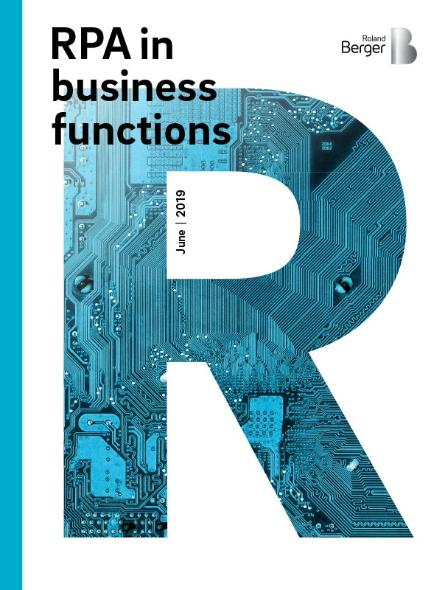Robotic process automation as a game-changer in business functions
![{[downloads[language].preview]}](https://www.rolandberger.com/publications/publication_image/Roland_Berger_523_RPA_in_business_functions_Cover_download_preview.jpg)
Robotic process automation (RPA), widely applied in corporate functions or back-office tasks, is as a tool for boosting efficiency in companies.


Robotic process automation (RPA) is already widely applied in corporate functions, or back-office tasks. But advances in technology in areas such as image processing, speech recognition and machine learning mean that RPA is finding increasing application in "business functions", too. In corporate functions, RPA can raise efficiency by 20-40 percent. But in business functions, it can increase company value by between five and seven percent – making it a real game-changer for companies.

"Robotic process automation is a tool for boosting efficiency in companies. But advances in technology in areas such as image processing, speech recognition, and machine learning mean that RPA is finding increasing application in 'business functions', too."
The software robot can be taught almost any repetitive, rule-based task that previously required human input. RPA can bridge interfaces between systems, capture and process data, interpret and trigger responses and even communicate with other systems, employees or clients. The technology can work independently and without supervision, taking on tasks that do not require human intelligence or individual decisions, or it can work side by side with employees. As a bonus, it usually requires no changes in the company's existing IT infrastructure.
The broader application of RPA – its gradual expansion from corporate functions into business functions – lends it even greater potential in terms of adding value. The impact of RPA is thus largely internal, with only limited effects on customer centricity or the company's external footprint. In business functions, by contrast, RPA unleashes value-creation potential, boosting the value of the goods, services or the entire business. In this way, the impact of RPA is external, too, positively affecting customer centricity and the company's external footprint and supporting overall value creation.
In the past, employees had to manually retrieve information, such as current locations and expected delivery dates for consignments, from different systems and then forward it to customers by phone or email. Roland Berger has helped automate this process using RPA. Our client implemented a robot that crawls information from all sources and populates a central, real-time database. Another RPA solution interprets customer inquiries received via email, chatbot or phone, retrieves the required information from the database and transmits it to the customer via the same channel.
Some suggest that RPA can only create value in certain industries or for certain sizes of company. We beg to differ. In our experience supporting companies, we have found that RPA can stimulate value creation in all types of companies, across all industries. What is important, however, is examining the company carefully and determining its characteristics. This enables us to implement RPA solutions with the highest value-creation potential.
RPA is an extremely powerful tool. However, realizing its full potential presents companies with several challenges. Here, it is essential to employ a structured approach, ensuring that the right technology is chosen for the right processes. Roland Berger uses a comprehensive methodology that helps organizations implement RPA solutions in complex business environments. The approach is driven by our belief that robotics is more than just an efficiency tool in business functions: It can directly unleash value by freeing up time that employees can then spend on a more valuable task.

![{[downloads[language].preview]}](https://www.rolandberger.com/publications/publication_image/Roland_Berger_523_RPA_in_business_functions_Cover_download_preview.jpg)
Robotic process automation (RPA), widely applied in corporate functions or back-office tasks, is as a tool for boosting efficiency in companies.